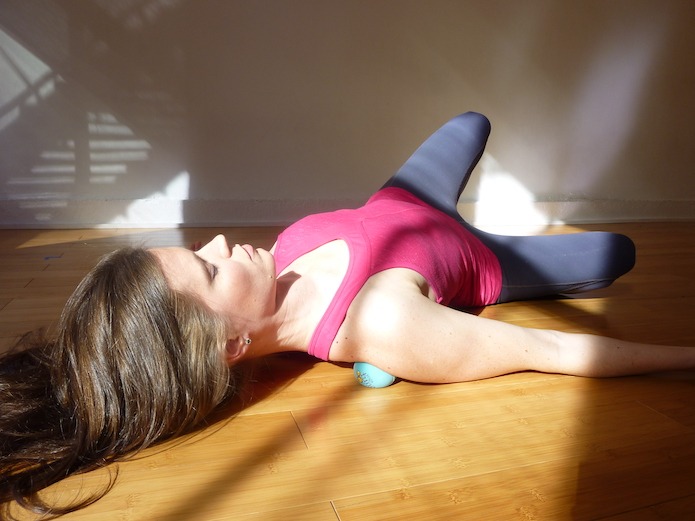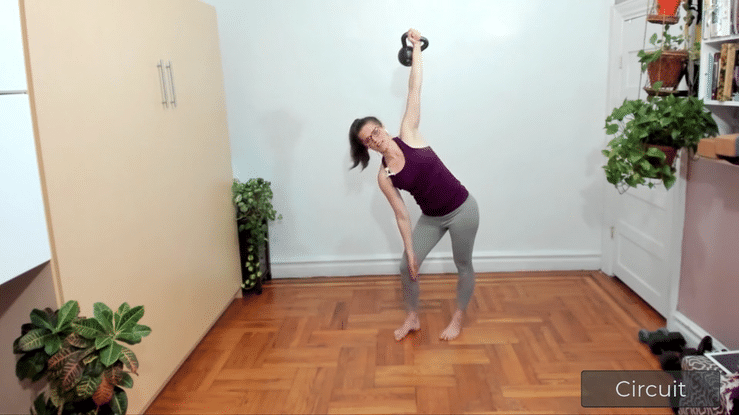My journey as a mover and movement educator has taken many twists and turns. Along the way I’ve picked up many different tools that I now incorporate freely in my virtual studio. I discovered each of them at specific times in my life, to serve specific needs—whether it was for mental or physical health, to get out of emotional pain or physical pain, or to liberate my teaching from rules I was beginning to question.

If an alien were to come down to Earth and look in that tool bag today, they might be confused by how it all makes sense—what do stretchy bands and blankets, foam blocks and rubber balls, and big, heavy weights have to do with one another? What kind of weird playground is this?
I still turn to my different movement tools for different reasons, but over the course of my learning through them I’ve actually come to notice some really key areas where they work together, as complementary practices.
In particular, self-massage and strength—which seem farthest apart on the movement spectrum—turn out to be quite a match made in heaven.
Here are some ways that these two practices can help us experience our bodies in the same-but-different kind of way:
- Both self-massage and strength improve body awareness (aka proprioception) but in different ways that we might categorize as passive vs. active.
Self-massage influences our passive structures through pressure and tension. (By passive structures, I mean the non-contractile ones, like skin, but also our soft tissues, like fascia, tendons, and ligaments.)

This pressure and tension is data our brain uses to make sense of our body position. Our skin and soft tissues are loaded with little data receptors (aka mechanoreceptors and proprioceptors) that sense this data and message it to our brain so it can process it and form a clearer inner portrait (AKA somatosensory map) of what our body position is.
Similarly (but different!) strength work influences our active structures (contractile ones, think muscles) through load that then requires them to contract, or generate active tension. This active tension is data, too. And it gets transferred to other structures (other muscles, fascia, tendon, ligaments, and even bone).
In totality, all of this tension—active and passive—helps our brain refine our body awareness.
- Self-massage and strength can make you more flexible, only one is more short-term and the other is more long-term.
After rolling on balls, it’s not uncommon to experience temporary increased range of motion.
For example, if you practice self-massage for your upper back, pay attention to whether or not you can take a deeper inhale afterwards. This may be your nervous system temporarily granting you more range of motion in rib elevation, which gives your lungs more room to expand.

Notice too, that after rolling, you’ll eventually go back to a baseline range of motion, so that increase you felt was temporary.
By contrast, getting stronger increases flexibility in a longer-lasting way. Specifically, when you strengthen muscles to make them more reliable for joint control, your nervous system might grant you more flexibility from the joints those muscles influence.
Here I’ll share a personal anecdote, which is that I used to have what felt like very stiff and inflexible hips. I also had hip pain. Then I started lifting heavy weights to strengthen my hip muscles and found that, rather quickly, my pain went away and my hips felt more flexible, too. I noticed quickly that I could sink deeper into stretches like pigeon and lizard pose without feeling so much muscle guarding.

My hunch is that by getting stronger, my nervous system felt safer and granted me more hip flexibility.
Finally, here’s a cool thing to keep in mind: In combining the temporary increased range of motion (ROM) we get from self-massage, and then layering strength onto that increased range, we can turn temporary flexibility from rolling into more long-term, useable range from strengthening. You might then consider coupling some rolling with sessions involving external load to get the full package!
- Both self-massage and strength work can reduce psychological stress (at least for me) but to different effect.
This one’s 100 percent personal and anecdotal, since we all need different input to find what feels like a balanced state of mind. But here goes: In general, on days when I feel like hiding from the world, I roll on balls. On days when I feel I must accomplish everything on my to-do list in one hour (and so instead I panic, freeze, and start doom-scrolling on Instagram) I know it’s time to put everything down and go lift weights or swing kettlebells.
In short, balls help me relax enough to rest. Weights unfreeze me so I can focus.

I know I’m not alone when I say that, especially during these turbulent times of the pandemic, my ups and downs are somewhat more frequent. That makes it nice to have two very different ways to get into my body depending on what I need. And, practicing this kind of self-awareness is a skill that both of these kinds of movement also reinforce.


Leave a Reply